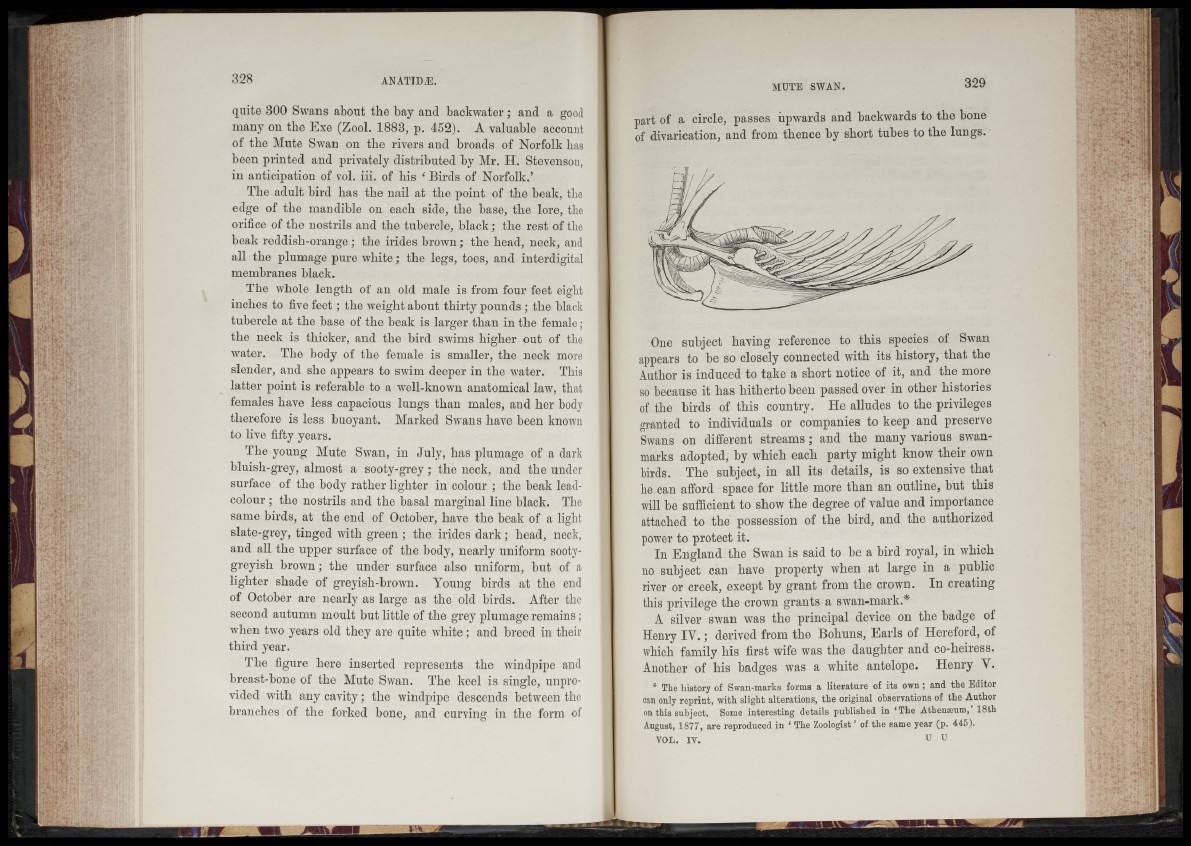
328 ANATIDÆ.
quite 300 Swans about the bay and backwater; and a good
many on the Exe (Zool. 1883, p. 452). A valuable account
of the Mute Swan on tlie rivers and broads of Norfolk has
been printed and privately distributed by Mr. H. Stevenson,
in anticipation of vol. iii. of bis ‘ Birds of Norfolk.’
Tlie adult bird lias the nail at the point of tlie beak, the
edge of the mandible on each side, the base, the lore, the
orifice of the nostrils and the tubercle, black; the rest of the
beak reddish-orange; the irides brown; the head, neck, and
all the plumage pure white; the legs, toes, and interdigital
membranes black.
The whole length of an old male is from four feet eight
inches to five feet; the weight about thirty pounds ; the black
tubercle at the base of the beak is larger than in the female;
the neck is thicker, and the bird swims higher out of the
water. The body of the female is smaller, the neck more
slender, and she appears to swim deeper in the water. This
latter point is referable to a well-known anatomical law, that
females have less capacious lungs than males, and her body
therefore is less buoyant. Marked Swans have been known
to live fifty years.
The young Mute Swan, in July, has plumage of a dark
bluisli-grey, almost a sooty-grey ; the neck, and the under
surface of the body rather lighter in colour ; the beak lead-
colour ; the nostrils and the basal marginal line black. The
same birds, at the end of October, have the beak of a light
slate-grey, tinged with green ; the irides dark; head, neck,
and all the upper surface of the body, nearly uniform sooty-
greyish brown; the under surface also uniform, but of a
lighter shade of greyish-brown. Young birds at the end
of October are nearly as large as the old birds. After the
second autumn moult but little of the grey plumage remains;
when two years old they are quite white; and breed in their
third year.
The figure here inserted represents the windpipe and
breast-bone of the Mute Swan. The keel is single, unprovided
with any cavity; the windpipe descends between the
branches of the forked bone, and curving in the form of
MUTE SWAN. 329
part of a circle, passes upwards and backwards to the bone
of divarication, and from thence by short tubes to the lungs.
One subject having reference to this species of Swan
appears to be so closely connected with its history, that the
Author is induced to take a short notice of it, and the more
so because it has hitherto been passed over in other histories
of the birds of this country. He alludes to the privileges
granted to individuals or companies to keep and preserve
Swans on different streams ; and the many various swan-
marks adopted, by which each party might know their own
birds. The subject, in all its details, is so extensive that
he can afford space for little more than an outline, but this
will be sufficient to show the degree of value and importance
attached to the possession of the bird, and the authorized
power to protect it.
In England the Swan is said to be a bird royal, in which
no subject can have property when at large in a public
river or creek, except by grant from the crown. In creating
this privilege the crown grants a swan-mark.*
A silver swan was the principal device on the badge of
Henry IY .; derived from the Bohuns, Earls of Hereford, of
which family his first wife was the daughter and co-heiress.
Another of his badges was a white antelope. Henry Y.
* The h istory of Swan-marks forms a lite ra tu re of its ow n ; an d th e Ed ito r
can only re p r in t, w ith slig h t a lte ra tio n s, th e original observations of th e Au th o r
on th is su b je ct. Some in te re stin g d e ta ils p u b lish ed in ‘The Athenaeum, 1 8 th
August, 1877, a re reproduced in ‘ The Zoologist ’ of th e same y ear (p. 445).
VOL. IV. u u